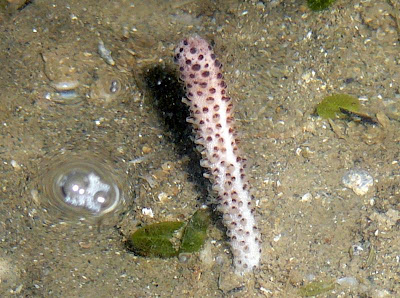Along with this last series of low tides for 2007, we visited Changi Beach once again. As mentioned in my Chek Jawa project blog, the northern shores are interconnected and each of them has an important role to play in the larger ecosystem of the surrounding waters. Though Changi is a much narrower stretch of intertidal zone, we can indeed proclaim that Changi is like Chek Jawa in terms of species.
On the high shore, Chay Hoon pointed to us this sea moth or sea robin (Pegasus volitans) that I've not seen before.
An old malay couple of grandpa and grandma casted a net and caught some marine organisms for their grandchildren to see. One of which is this blue-spotted stingray (Dasyatis kuhli).
and a couple of solefishes.
Chay Hoon found this very tiny Pygmy squid too.
Just like the sandbar of Chek Jawa, sand dollars also dwell and bury themselves under the sandflat of Changi. Sand dollars have tiny spines that cover their entire body.
Another marine creature that can be found in the proximity of Changi's sandflat will be this pair of moon snails that are getting intimate.
Sea cucumbers come in all sorts of shapes and sizes, and I have no idea what species is this.
Like Chek Jawa and recently Pulau Sekudu, Changi begins to house these mussel beds. The mussels (Musculista senhousia) produces byssus threads that trap sediments and eventually form these mussel beds. They tend to be covered with seaweed.
Brittlestars crawl about the seagrass and seaweed flats, similar to those in Chek Jawa.
What was special that evening were the enormous number of juvenile sandstars (Astropecten sp.). These sand stars are very common in Chek Jawa as well.
That day was also the first time I encountered the pencil sea urchins. It made me quite excited. Most of these sea urchins graze on algae. What is amazing about the pencil sea urchins is that they have spines on its spines. Can we call them secondary spines just like secondary roots? Haha.
These are the four carpet anemones I've encountered. Chek Jawa is known to have a lot of these charismatic carpet anemones, and I believe Changi also. However, poachers ensured that they are continuously being removed from the shores, constantly disrupting the ecosystem balances.
On a rock structure, there is a tiny patch of hard coral.
And also good growths of sponges. Too bad there were no nudibranches around, since they feed on sponges.
While looking around, I saw this bump on the sandflat.
I went to check it out and woah, the solefish was revealed. Apparently, its bumpy-dinner gave its disguise away.
Chay Hoon again spotted this tiny and very cute juvenile seastar. Compare its size with the fern seagrass (Halophila spinulosa). We believe it is probably a biscuit sea star (Goniodiscaster scabra).
Just like the seagrass beds of Chek Jawa, there were a lot of these thorny sea cucumbers (Colochirus quadrangularis). Wonder whether are they seasonal as I don't remember finding any during mid 2007. Perhaps they were also recovering from the early 2007 flooding or heavy rain that lowered the salinities of the seas. This sea cucumber in particular has its feeding tentacles extended out to gather suspended detritus by waving their tentacles.
I am very excited again to spot something new to me. This pebble crab (Leucosia vittata) can also be found, but seldomly, in Chek Jawa according to Ria's Chek Jawa Guidebook.
The sea pencil (Cavernularia sp.) are actually related to cnidarians like corals, anemones and jellyfishes. It is a colony of many animals.
There were two hermit crabs attached to each other, and we have no idea what they were trying to do.
Chay Hoon spotted this small transparent-like anemone attached to the sandflat.
Other wonders found include the numerous white sea urchins (Salmacis sp.) scattered all over. I accidentally stepped on some while wading in murky waters. Their sizes are bigger than those I usually sea. Also found, this time by Justin, is the spongy looking sea squirt and also the elbow crab. Moon crabs are common residents of Changi beach, but weird to say, saw only one that night.
Who says you only can find large populations of these button shells (Umbonium vestiarum) in Chek Jawa? Changi has them too! But please do not collect them home. They are alive, and even dead ones can be used by hermit crabs as home.
I believe almost all of the above marine creatures found in Changi can be found in Ria's Chek Jawa guidebook. Changi never fails to surprise! If you don't believe, check out Ron's blog post on his Changi visit the next day of our trip. He found many different rare seastars that made me all envy and jealous. :-)
Indeed Changi is so like Chek Jawa, we cannot dismiss such an amazing shore as one that has little or no natural heritage.
Saturday, December 29, 2007
Changi is a mini-Chek Jawa
Subscribe to:
Post Comments (Atom)




























4 comments:
that hard coral is oulastrea (if you wanna practise ur ID)
*jealous* have never seen a sea moth before!!
thanks for the id juanhui! I'm too lazy to check :P
Wow! Great finds and great photography!
The moon snails look like they are emerging from under a transparent blob of jellyfish stranded at low tide...hmm? Just a thought. : )
Hi Joseph! Glad to see you here and thanks for your encouragement.
The moon snails were not near any jellyfishes from what I recall from the trip. But nevertheless, they are fascinating.
Post a Comment